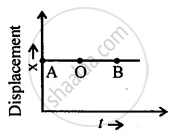Advertisements
Advertisements
Question
A car is moving in a straight line with speed 18 km h-1. It is stopped in 5 s by applying the brakes. Find:
- the speed of car in m s-1
- the retardation and
- the speed of car after 2 s of applying the brakes.
Solution
Given, speed of car = 18 km h-1
(i) To convert speed to m s-1
`18 " km h"^-1 = (18 " km")/(1 " h") = (18 xx 1000 " m")/(60 xx 60 " s")`
`=> 18 " km h"^-1 = (18 xx 10 " m")/(6 xx 6 " s")`
`=> 18 " km h"^-1 = 5 "m s"^-1`
Hence, 18 km h-1 is equal to 5 m s-1.
(ii) As the car is stopped, the final velocity = 0
initial velocity (u) = 18 km h-1
As we know,
Acceleration (a) = `("Final velocity (v)" - "initial velocity (u)")/("time (t)")`
Given, Initial velocity (u) = 5 m s-1
Final velocity (v) = 0
Time (t) = 5 s
Substituting the values in the formula above, we get,
Acceleration (a) = `(0 - 5)/5`
Acceleration (a) = `- 5/5`
Acceleration (a) = - 1 ms-2
Hence, acceleration of the car is -1 m s-2. Negative sign shows that the velocity decreases with time, so retardation is 1 m s -2.
(iii) Given, t = 2 s, a = -1 m s-2, u = 5 m s-1
Substituting the values in the formula for acceleration, we get,
`=> - 1 "ms"^-2 = ((v - 5)"ms"^-1)/(2s)`
`=> -2ms^-1 = (v - 5)ms^-1`
⇒ v = (5 - 2) ms-1
⇒ v = 3 ms-1
Hence, the speed of car after 2 s of applying the brakes = 3 m s-1.
APPEARS IN
RELATED QUESTIONS
During an experiment, a signal from a spaceship reached the ground station in five minutes. What was the distance of the spaceship from the ground station? The signal travels at the speed of light, that is, 3 × 108m s−1.
Convert a speed of 54 km/h into m/s.
A car is moving along a straight road at a steady speed. It travels 150 m in 5 seconds:
How long does it take to travel 240 m ?
A train starting from rest moves with a uniform acceleration of 0.2 m/s2 for 5 minutes. Calculate the speed acquired and the distance travelled in this time.
The speed of a moving object is determined to be 0.06 m/s. This speed is equal to :
Give an example of the motion of a body moving with a constant speed but with a variable velocity. Draw a diagram to represent such a motion.
Give one example of following motion :
Uniform velocity
A train takes 2 h to reach station B from station A, and then 3 h to return from station B to station A. The distance between the two stations is 200 km. Find:
The average speed,
The average velocity of the train.
Write down the type of motion of a body along with the A – O – B of the following distance – time graph.

Distinguish between speed and velocity.
